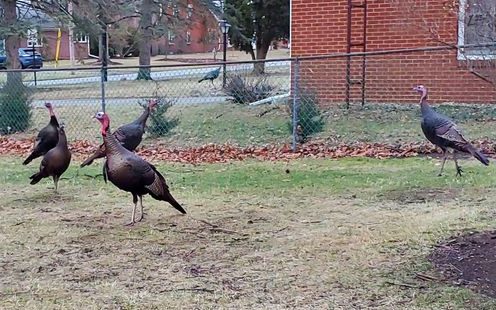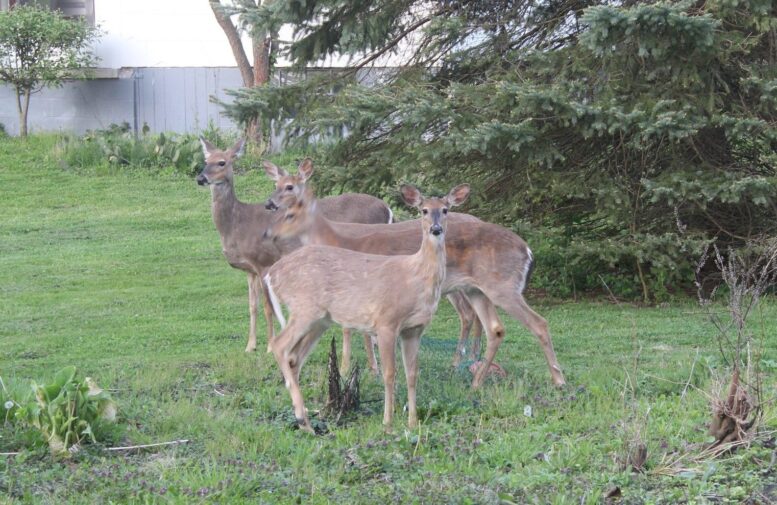By JAN McLAUGHLIN
BG Independent News
Bowling Green wants its residents to pack away the peanuts and stop peppering their yards with salt licks.
On Monday evening, City Council will hear the introduction of an ordinance prohibiting outdoor feeding of wild animals in the community – except for feeders for songbirds.
Working with the ODNR, Bowling Green came up with legislation intended to prevent deer from devouring landscaping plants, turkeys from pecking people, and raccoons and opossums from crawling into spaces they don’t belong in houses. The proposed ordinance is based on one already enacted in the city of Dublin.
Wild animals fed by humans can become accustomed to people, according to ODNR, causing the animals to lose their fear of people and become aggressive. So in order to promote a safer and healthier community, City Council is being asked to adopt an ordinance prohibiting the feeding of wild animals.
The ordinance addresses other negative impacts from wild animals being fed by residents, including the spread of disease, disruption of natural foraging behaviors, more vehicle-animal crashes, damage to landscaping, and aggressive animal behaviors.
The ordinance covers feeding of domesticated animals that are running without a leash, and wild animals including squirrels, chipmunks, groundhogs, raccoons, skunks, opossums, muskrats, deer, foxes, black bears, wild turkeys, bobcats and coyotes.
“We’re hoping people aren’t too upset,” said BG City Communications Director Amanda Gamby. “We’re not restricting the feeding of songbirds.”
Gamby said the ordinance was drafted out of concern for wildlife.
“The community can coexist with wildlife,” she said. “But feeding animals ultimately leads to conflict” with neighbors and the plants they feast on, and with motorists not expecting a whole family of deer to leap across streets or a flock of turkeys to take their time moseying across roads.
City officials have heard from residents annoyed with their neighbors who put out salt licks for deer, and peanuts in the shell for other animals.

After last year’s incidents of wild turkeys being aggressive with residents and mail carriers in some neighborhoods, the Ohio Department of Natural Resources tried to capture some of the more peckish male turkeys to relocate them to other areas.
ODNR staff noted several homes where bowls of food were left out for wildlife.
While the netting effort was not successful, it appears the wild turkeys – known for their intelligence – relocated themselves to places like Wintergarden Park to avoid the netting attempts by ODNR.
“We’re trying to prevent that from happening in the future,” Gamby said of ODNR trapping efforts. “We don’t want to get to the point where we have to move animals or euthanize them.”
The feeding of a resident’s own animals or wild birds on their premises will be exempted so long as the food does not attract wild animals or animals running at large.
According to the ordinance, violations of the ordinance will be minor misdemeanors, with each day that a violation continues being deemed a separate offense.
The City of Bowling Green website lists several tips from ODNR about humans coexisting with wild animals. The info page also lists resources that may be helpful, and answers to frequently asked questions.
ODNR information
While the growth of communities displaces some wildlife, many species continue to live in the habitat available in parks, undeveloped parcels of land and vacant lots, and in backyards.
People and wildlife can peacefully coexist in most situations, according to the Ohio Department of Natural Resources. However, there may be times when conflicts arise.
Tips to avoid problems:
- Do not feed wildlife. If you choose to feed songbirds, place the feeder where it is inaccessible to other wildlife species. Use a feeder with a gravity-operated treadle to discourage squirrels and don’t let spilled food accumulate on the ground below. Feeders should be 4.5 feet off the ground. The use of a platform feeder (again, 4.5 feet off the ground) can assist with drawing in certain species of birds without putting the food on the ground.
- Trim tree branches that extend over your roof or install a three-foot-wide band of sheet metal (six feet above the ground) around the trunks of trees that overhang your house. This will reduce the access raccoons have to your roof.
- Cover window wells with grates, bubbles or hardware cloth.
- Keep pet food inside.
- Seal up holes around and under home foundations.
- Bury 1/4-inch mesh hardware cloth 1 to 2 feet deep or layer horizontally just below ground level at least 2 feet around any building foundations, pavement pads or in places where animals might gain access through digging.
- Store garbage in metal or plastic containers with tight-fitting lids. Keep the containers in the garage or shed and put trash out only when it is scheduled for pick up.
- Fence gardens and cover fruit trees and berry bushes with netting. Screen fireplace chimneys and furnaces (from February to September) as well as attic and dryer vents. Keep dampers closed when not in use (consult a knowledgeable source to prevent fire or safety hazards).
- Decks built less than two feet off the ground should have 1/4-inch mesh hardware cloth nailed from the top of the outside joists to the bottom of a 10-inch trench, leaving about six to eight inches of extra hardware cloth at the bottom to form an L-shape. Wooden lattice can be added for aesthetics.
- Seal all holes and cracks in your foundation, siding or stucco that is larger than 3/8 inch wide to keep rats, mice, bats and snakes out. Common entry points include chimneys; gaps around window air conditioners, water pipes or electric outlets; openings in interior walls that lead to the attic or ceiling; loose or shrunken siding boards; and loose vent covers.
- Repair broken, weak or rotted areas on the roof, soffit and fascia of your house.
- Mark large windows with strips of white tape or raptor (hawk) silhouettes to avert birds from flying into the window.
- Do not handle or move orphaned or injured wildlife. Visit: Orphaned and Injured Wildlife | Ohio Department of Natural Resources to learn more about orphaned or injured wildlife.
Resources:
- General Prevention of Nuisance Wildlife | Ohio Department of Natural Resources (ohiodnr.gov)
- Nuisance Wildlife Resources | Ohio Department of Natural Resources (ohiodnr.gov)
- Nuisance Species: Deer | Ohio Department of Natural Resources (ohiodnr.gov)
- Ohio Landowner/Hunter Access Partnership Program | Ohio Department of Natural Resources (ohiodnr.gov)
- Animals In Need Guide | Nature’s Nursery
Urban Wildlife FAQs
- Who should I contact to remove nuisance wildlife from my property?
- I have found sick or injured wildlife. Who do I contact for help?
- I have found an orphaned baby wildlife. What do I do?
- I’ve encountered a sick, injured, caught, or trapped deer. Who do I contact for help?
- Who do I contact to remove a dead deer from my property?
- Wild turkeys are becoming a nuisance on my property. What should I do?
- I’ve found a fawn in my yard. What do I do?
- I have a bat in my house. What do I do?



